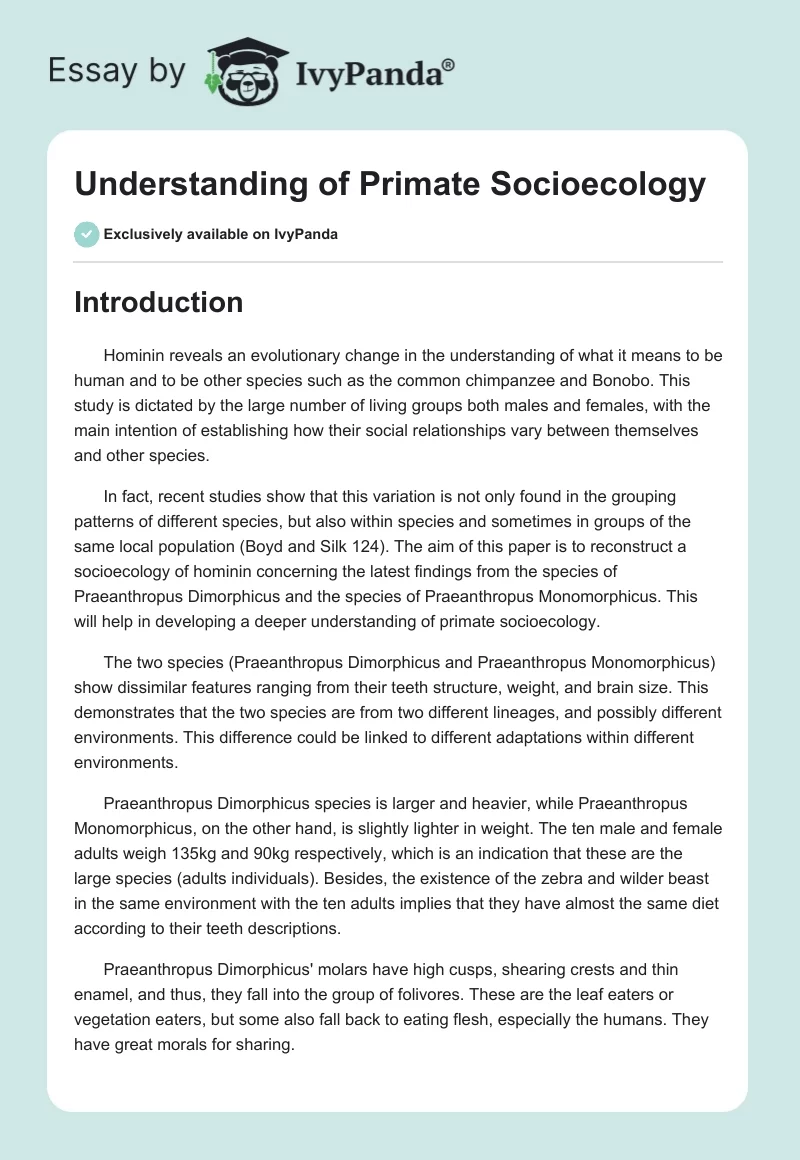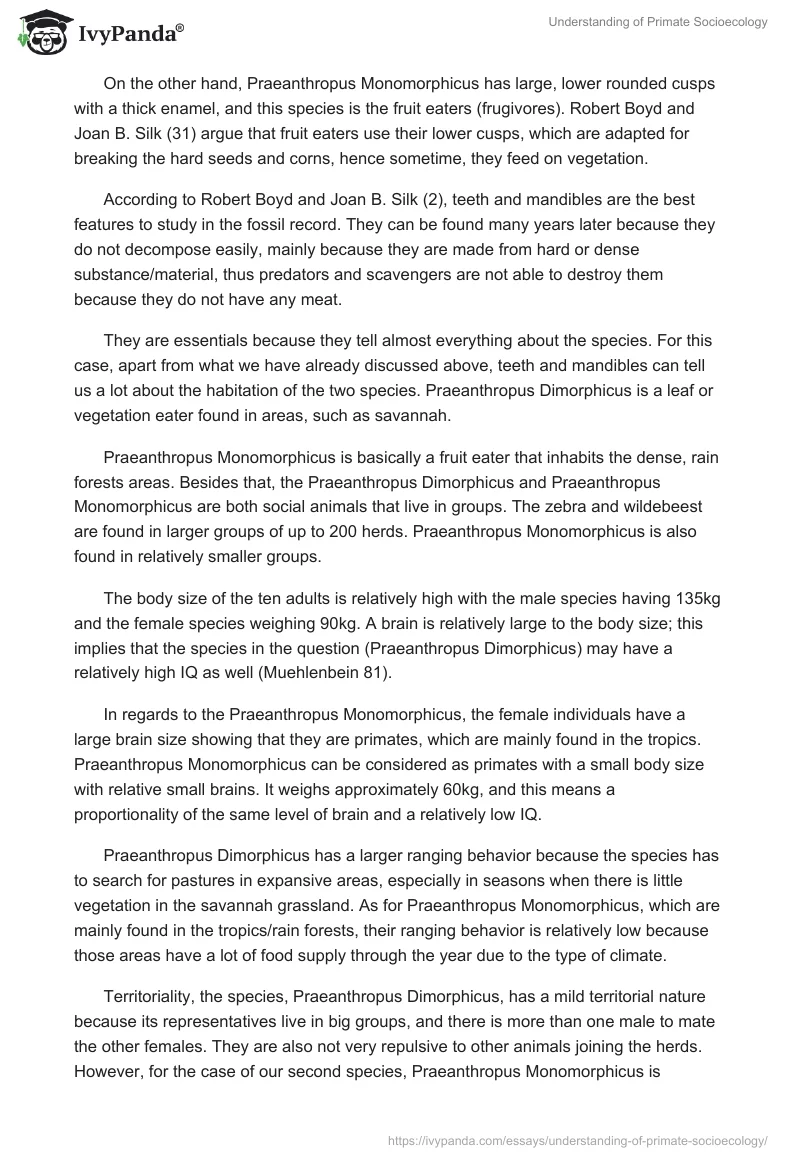Introduction
Hominin reveals an evolutionary change in the understanding of what it means to be human and to be other species such as the common chimpanzee and Bonobo. This study is dictated by the large number of living groups both males and females, with the main intention of establishing how their social relationships vary between themselves and other species.
In fact, recent studies show that this variation is not only found in the grouping patterns of different species, but also within species and sometimes in groups of the same local population (Boyd and Silk 124). The aim of this paper is to reconstruct a socioecology of hominin concerning the latest findings from the species of Praeanthropus Dimorphicus and the species of Praeanthropus Monomorphicus. This will help in developing a deeper understanding of primate socioecology.
The two species (Praeanthropus Dimorphicus and Praeanthropus Monomorphicus) show dissimilar features ranging from their teeth structure, weight, and brain size. This demonstrates that the two species are from two different lineages, and possibly different environments. This difference could be linked to different adaptations within different environments.
Praeanthropus Dimorphicus species is larger and heavier, while Praeanthropus Monomorphicus, on the other hand, is slightly lighter in weight. The ten male and female adults weigh 135kg and 90kg respectively, which is an indication that these are the large species (adults individuals). Besides, the existence of the zebra and wilder beast in the same environment with the ten adults implies that they have almost the same diet according to their teeth descriptions.
Praeanthropus Dimorphicus’ molars have high cusps, shearing crests and thin enamel, and thus, they fall into the group of folivores. These are the leaf eaters or vegetation eaters, but some also fall back to eating flesh, especially the humans. They have great morals for sharing.
On the other hand, Praeanthropus Monomorphicus has large, lower rounded cusps with a thick enamel, and this species is the fruit eaters (frugivores). Robert Boyd and Joan B. Silk (31) argue that fruit eaters use their lower cusps, which are adapted for breaking the hard seeds and corns, hence sometime, they feed on vegetation.
According to Robert Boyd and Joan B. Silk (2), teeth and mandibles are the best features to study in the fossil record. They can be found many years later because they do not decompose easily, mainly because they are made from hard or dense substance/material, thus predators and scavengers are not able to destroy them because they do not have any meat.
They are essentials because they tell almost everything about the species. For this case, apart from what we have already discussed above, teeth and mandibles can tell us a lot about the habitation of the two species. Praeanthropus Dimorphicus is a leaf or vegetation eater found in areas, such as savannah.
Praeanthropus Monomorphicus is basically a fruit eater that inhabits the dense, rain forests areas. Besides that, the Praeanthropus Dimorphicus and Praeanthropus Monomorphicus are both social animals that live in groups. The zebra and wildebeest are found in larger groups of up to 200 herds. Praeanthropus Monomorphicus is also found in relatively smaller groups.
The body size of the ten adults is relatively high with the male species having 135kg and the female species weighing 90kg. A brain is relatively large to the body size; this implies that the species in the question (Praeanthropus Dimorphicus) may have a relatively high IQ as well (Muehlenbein 81).
In regards to the Praeanthropus Monomorphicus, the female individuals have a large brain size showing that they are primates, which are mainly found in the tropics. Praeanthropus Monomorphicus can be considered as primates with a small body size with relative small brains. It weighs approximately 60kg, and this means a proportionality of the same level of brain and a relatively low IQ.
Praeanthropus Dimorphicus has a larger ranging behavior because the species has to search for pastures in expansive areas, especially in seasons when there is little vegetation in the savannah grassland. As for Praeanthropus Monomorphicus, which are mainly found in the tropics/rain forests, their ranging behavior is relatively low because those areas have a lot of food supply through the year due to the type of climate.
Territoriality, the species, Praeanthropus Dimorphicus, has a mild territorial nature because its representatives live in big groups, and there is more than one male to mate the other females. They are also not very repulsive to other animals joining the herds. However, for the case of our second species, Praeanthropus Monomorphicus is territorial, and the dominant male is responsible for mating with the females in the group.
Conclusion
This study is necessary because it gives an unpredictability of social systems among different species. It helps scientifically analyze various associations within this species and between different species. It is also particularly appropriate in investigating the forces that cause the changes in the social organizations and the results of such shifts. It is an informative insight into the observable differences between the different species in terms of their behavior, as well as adaptations.
Works Cited
Boyd, Robert and Joan B. Silk. How Humans Evolved. 5th edn. New York: W.W. Norton, 2009. Print.
Muehlenbein, Michael. Human Evolutionary Biology. Cambridge: Cambridge University Press, 2010. Print.


